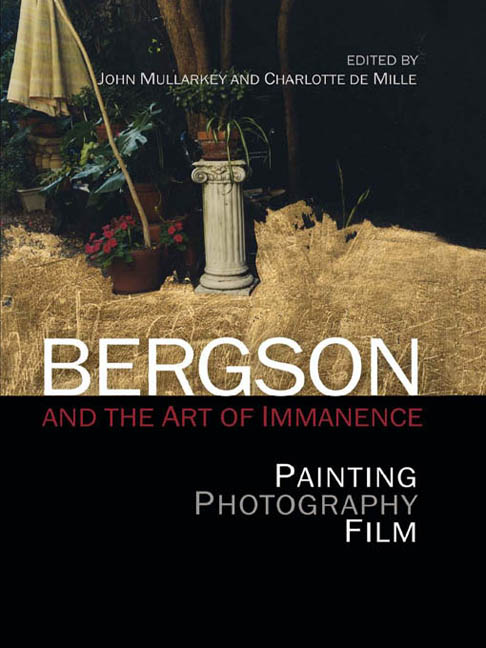Book contents
- Frontmatter
- Contents
- List of Illustrations
- Notes on Contributors
- Introduction: Art's Philosophy – Bergson and Immanence
- Part I Bergson, Art, History
- Part II Unconditional Practice
- Part III Immanence of the Visible
- 11 Painting the Invisible: Time, Matter and the Image in Bergson and Michel Henry
- 12 ‘For We Will Have Shown it Nothing’: Bergson as Non-Philosopher (of) Art
- 13 The Untimeliness of Bergson's Metaphysics: Reading Diffractively
- 14 Hyperaesthesia and the Virtual
- Afterword: An Art Historical Return to Bergson
- Index
11 - Painting the Invisible: Time, Matter and the Image in Bergson and Michel Henry
from Part III - Immanence of the Visible
Published online by Cambridge University Press: 07 December 2017
- Frontmatter
- Contents
- List of Illustrations
- Notes on Contributors
- Introduction: Art's Philosophy – Bergson and Immanence
- Part I Bergson, Art, History
- Part II Unconditional Practice
- Part III Immanence of the Visible
- 11 Painting the Invisible: Time, Matter and the Image in Bergson and Michel Henry
- 12 ‘For We Will Have Shown it Nothing’: Bergson as Non-Philosopher (of) Art
- 13 The Untimeliness of Bergson's Metaphysics: Reading Diffractively
- 14 Hyperaesthesia and the Virtual
- Afterword: An Art Historical Return to Bergson
- Index
Summary
There are intriguing parallels between the thought of Bergson and that of the radically unorthodox phenomenologist Michel Henry, although the latter, so far as I can tell, made little or no reference to the former and identified wholly – if also dissentingly – with phenomenology. Bergson's philosophy in any case has much in common with phenomenology, through shared origins in nineteenthcentury psychology; Bergson, like William James and Franz Brentano, conducted a philosophical enquiry into psychic life, in contrast to the scientistic experimentalism of the psycho-physicians. In France, Bergson's thought left traces in the work of both Sartre and Merleau- Ponty. Henry, a philosopher of a later generation, began his work when phenomenology, rather than Bergsonian philosophy, was the prevailing and rising current of thought in France, and his entire effort, from the outset of his career to his death, consisted in radically interrogating and revising this inheritance, principally with reference to Husserl and Heidegger. His great contribution consisted in developing a phenomenology of affectivity and immanence, and it was this that brought him, without his apparent intention, into a certain proximity with Bergson. I want to examine this unacknowledged affinity – while taking note of significant underlying differences – with reference to certain shared or comparable motifs. Central among these is a critique of representation that is set out in different but partly congruent terms in the thought of both philosophers, though Henry alone calls into question the representation of the visible in art. It is here that Henry's book on Kandinsky comes into play, and I have evoked its challenging title, Seeing the Invisible (Voir l'invisible), in my own.
Bergson himself does not make play with the idea of invisibility, nor is he especially concerned with the visible as such, normally deploying instead the concept of perception in general. Unlike Henry, and in still greater contrast with Merleau-Ponty, Bergson made scant reference to painting. While the remarks he did make are significant, I intend to show that, more than what he actually said about painting, it is rather his concept of the durational nature of consciousness that is illuminating both for the way we see paintings and for the act of pictorial representation. For indeed – perhaps surprisingly – representational painting (in the Western, post-renaissance tradition) has particular relevance for Bergson, and in this there is a marked contrast with Henry.
- Type
- Chapter
- Information
- Bergson and the Art of ImmanencePainting, Photography, Film, Performance, pp. 189 - 205Publisher: Edinburgh University PressPrint publication year: 2013



